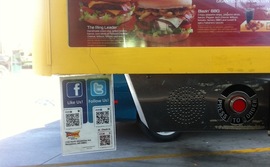 With Foursquare topping headlines in the past year, many businesses are hopping on the location-based marketing (LBM) bandwagon.
With Foursquare topping headlines in the past year, many businesses are hopping on the location-based marketing (LBM) bandwagon.
While many merchants hope check-ins will immediately generate sales, most are finding that to be far from the case. Turning check-ins into real-world sales isn’t as easy as it sounds.
As a business owner, how can you ensure your LBM activities impact bottom-line sales?
Below are five tips to set up a successful LBM program. In a time when location-aware apps are multiplying like rabbits, these strategies will help you avoid the dreaded check-in fatigue afflicting many a connected consumer today.
1. Pick a Platform (or a Couple)
There are many location-based applications these days, all vying for your business. Do your homework and check out the top platforms (Foursquare, Gowalla, Facebook Places, Yelp) and see if your target audience is using them.
Survey your customers through your existing social networks or as part of your traditional direct mail outreach via mail. The check-in services favored by your current fans and customers should be your first deployments, but don’t forget to investigate other location-based communities that may yield whole new customer streams.
2. Stake Your Claim
Chances are, if your customers are already using location-based apps, your brick-and-mortar locations are included in locations listings within their database. Join these networks (all of them) and make sure your listing information associated with your listing is correct.
In many cases, a link from the web page will let you claim ownership of a place. Claiming ownership normally gives you admin rights to information on the page, but also enables you to offer deals, specials, and coupons. Always be sure to include your URL in these listings as location-based application pages are highly indexed in search engine results.
3. Start Small
Not every business has the ability to be Gap and drive customers to stores with the allure of free denim on the first day of Facebook Places. Test small deals in a number of locations (if you’re multi-location) or a specialized deal if you’re a single location.
The types of offers you present via location-based services are varied. Evaluate offer types with the goal of not just driving foot traffic and sales, but also keeping costs and your bottom line in mind. Small and medium-sized businesses can lose out with location-based and daily deal sites, because they don’t fully realize the impact these promotions have on things like staffing, materials, and overall profitability.
4. Switch it Up
Location-based deals can get stale after a while as regular patrons either unlock them, or give up coming back once they realize they don’t have a chance at attaining the “mayor” deal (a deal only given to the mayor of a certain location). Focus on sharing and remember that users who are interacting with a brand in a positive way are likely to share information about that experience with friends and colleagues.
Experiment with different deal structures and see which are being redeemed more often. This is all part of measuring effectiveness of campaigns and should be a part of any marketing initiative.
5. Take Part
Brands using location-based marketing have seen great interactions with target audiences. Brands like Bravo, H&M, Epicurious, History Channel, and Windows Live are interacting with their communities not only digitally, but taking that experience into the real world by connecting experiences online to physical places (Disclosure: Microsoft, makers of Windows Live, is a client of my company).
As a brand on Foursquare, you can leave tips in places that are important to your community. For example, The History Channel lets users search #historychannel in Foursquare and see info about historical and interesting places to visit. Also, large brands are working with platforms to create their own badges, stickers, etc. that users can collect from checking in.
Windows Live does an amazing job of showcasing great spots to take photos (tying in Windows Live Photo Gallery) all over the globe. This is a great example of a brand that has no physical location taking advantage of location to interact with its community.
Summary
The LBM game isn’t slowing down; rather, it’s ramping up. Planning and taking the time to learn about the different platforms, options, and dynamics goes a long way in determining strategy (and ultimately success) in the location-based world.
 With Foursquare topping headlines in the past year, many businesses are hopping on the location-based marketing (LBM) bandwagon.
With Foursquare topping headlines in the past year, many businesses are hopping on the location-based marketing (LBM) bandwagon.